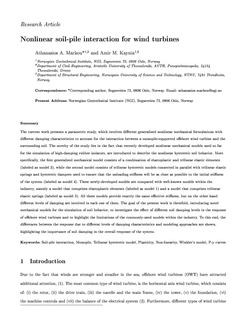Nonlinear soil-pile interaction for offshore wind turbines
Journal article, Peer reviewed
Accepted version
Permanent lenke
http://hdl.handle.net/11250/2492948Utgivelsesdato
2018Metadata
Vis full innførselSamlinger
Sammendrag
The current work presents a parametric study, which involves different generalized nonlinear mechanical formulations with different damping characteristics to account for the interaction between a monopile‐supported offshore wind turbine and the surrounding soil. The novelty of the study lies in the fact that recently developed nonlinear mechanical models used so far for the simulation of high‐damping rubber isolators are introduced to describe the nonlinear hysteretic soil behavior. More specifically, the first generalized mechanical model consists of a combination of elastoplastic and trilinear elastic elements (labeled as model 3), while the second model consists of trilinear hysteretic models connected in parallel with trilinear elastic springs and hysteretic dampers used to ensure that the unloading stiffness will be as close as possible to the initial stiffness of the system (labeled as model 4). These newly developed models are compared with well‐known models within the industry, namely, a model that comprises elastoplastic elements (labeled as model 1) and a model that comprises trilinear elastic springs (labeled as model 2). All these models provide exactly the same effective stiffness, but on the other hand different levels of damping are involved in each one of them. The goal of the present work is 3‐fold, introducing novel mechanical models for the simulation of soil behavior, to investigate the effect of different soil damping levels in the response of offshore wind turbines and to highlight the limitations of the commonly used models within the industry. To this end, the differences between the response due to different levels of damping characteristics and modeling approaches are shown, highlighting the importance of soil damping in the overall response of the system
